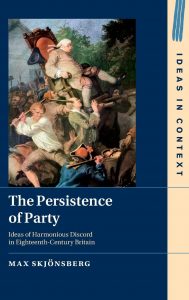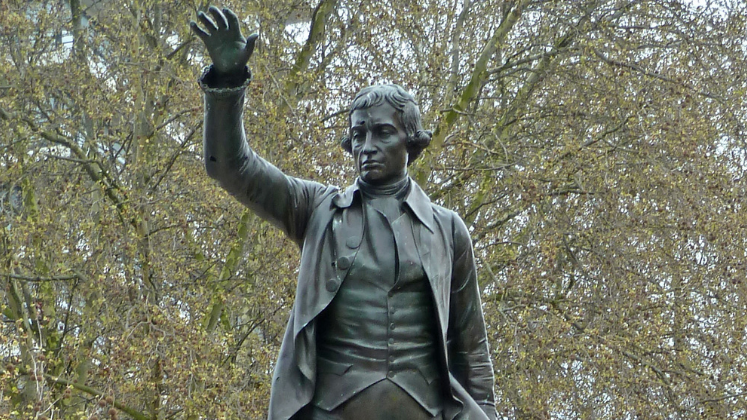In The Persistence of Party: Ideas of Harmonious Discord in Eighteenth-Century Britain, Max Skjönsberg offers a new intellectual history exploring the discussion of party politics in eighteenth-century Britain, focusing on a series of thinkers who heavily influenced one another’s views of parties and partisanship. Uncovering the ways in which the appreciation of party politics came about in the eighteenth century, Skjönsberg’s excellent book not only contributes to intellectual history but also offers us a new reason to think that the cure for the increasingly troubling political polarisation today may still need to include vibrant partisan competitions, writes Antong Liu.
The Persistence of Party: Ideas of Harmonious Discord in Eighteenth-Century Britain. Max Skjönsberg. Cambridge University Press. 2021.
 Find this book (affiliate link):
Find this book (affiliate link): ![]()
Political parties are both familiar and strange to us today. On the one hand, despite the growing worry about worldwide political polarisation, it is still widely acknowledged that party competition is indispensable to modern democracies. On the other hand, it remains underexplored how this contemporary appreciation of party politics came about. Parties too often were, and still occasionally are, dismissed as the expression of corrupt and dangerous factionalism. At best, they were tolerated as an unavoidable inconvenience that a society must somehow accommodate.
According to scholars such as Harvey Mansfield and Nancy Rosenblum, this negative attitude toward parties did not change until as late as the mid-eighteenth century, when politician and philosopher Edmund Burke actively defended partisanship for its role in maintaining the liberty of Britain. But in light of the rich history of party politics, especially after the ‘Glorious Revolution’ of 1688 that replaced King James II with Mary and William of Orange, this scholarly view broaches a new set of questions: how did Burke arrive at his defence of parties and partisanship? Was there nothing appreciative to be said about party politics before Burke at all? And how did the meaning of ‘party’ evolve with the changing history of British politics throughout the eighteenth century? These are the questions to which intellectual historian Max Skjönsberg aims to respond.
The Persistence of Party is an original book. Skjönsberg offers a rich intellectual history revolving around the discussion of party politics in eighteenth-century Britain. This history focuses on a series of thinkers who heavily influenced one another’s view of parties and partisanship, such as Paul de Rapin-Thoyras, Bolingbroke, David Hume and John Brown. Burke, the usual starting point of such a history, is also included but appears only at the end of the book. This arrangement is in accordance with Skjönsberg’s argument: the theoretical defence of party politics culminated in, rather than began with, Burke’s attack on Bolingbroke.
 Image Credit: Cropped image of ‘Edmund Burke’ (Tim Green CC BY 2.0)
Image Credit: Cropped image of ‘Edmund Burke’ (Tim Green CC BY 2.0)
To make this point, Skjönsberg re-evaluates, for instance, the legacy of Bolingbroke’s account of parties. Against the common view that Bolingbroke was an anti-party thinker whose endorsement of an opposition party aimed only to end all parties, Skjönsberg argues that Bolingbroke was sensible enough to believe that party politics would not cease with the downfall of any particular parties (101). Accordingly, Burke’s engagement with Bolingbroke should be understood more as a development than a negation of the latter’s thoughts on party politics.
Meanwhile, Skjönsberg’s attempt to illustrate the continuity in intellectual history does not amount to a Whig or Hegelian historiography, which, in this case, treats the triumph of party politics as an inevitable result of history. Instead, aiming also to reconstruct the political history of eighteenth-century Britain from the oft-ignored angle of party politics, he pays close attention to the detailed political and intellectual context of the writings he examines. This includes the historical events to which the examined thinkers referred and the political debates in which politicians engaged. The close connection that Skjönsberg reveals between the history and the thought of party politics shows that, in the century when parliamentary democracy was trialled, the defence of party was far from ‘a straightforward narrative of intellectual progress’ (6).
A telling indication of the extent to which the thought of party politics was embedded in political history is that the examined thinkers seldom defended or criticised parties and partisanship in abstract. In the first half of the eighteenth century, the menace of Jacobitism (which sought to restore the House of Stuart to the British throne) to the Glorious Revolution fuelled the suspicion of party politics (30). As Jacobitism died down, the friendlier atmosphere for the defence of party politics rendered it possible for writers to delve into this topic. Meanwhile, the decline of the Tories and the corruption of the Whigs under the leadership of Robert Walpole gave rise to the idea of the opposition between the Country and Court parties. According to Skjönsberg, this development was foreshadowed in Rapin’s discussion of parties (71) and later culminated in Bolingbroke’s urge to abandon the Tory-Whig polarisation to mobilise organised partisan resistance to Walpole and the Court party (89). Later, party opposition became most conspicuous among different groups of the Whigs, and it was in this context that Burke’s political career and theory of party politics were situated. Even Hume, who seemed to follow in Rapin’s footsteps and thus exhibited little partisanship in his writings, largely framed his theoretical analysis of parties as a sympathetic critique of Toryism and Whiggism (171). In this way, Skjönsberg shows us that even the meaning of party was not entirely determined in the eighteenth century.
It is thus clear that Skjönsberg aims to strike a balance between the continuity and discontinuity in history (6), such that changing historical accounts are not only interesting in themselves but also can help us ponder perennial theoretical questions that are still relevant to us today (334). This affinity for balance also characterises the content of the book. For instance, in his account of Hume, Skjönsberg emphasises how Hume accepted the inevitability of partisanship and how he exhorted partisans to practise moderation in their political competition (172).
More importantly, party politics, according to Skjönsberg, is an institutionalised way to achieve ‘harmonious discord’ in politics (7). Such harmonious discord is necessary, as harmony with concord is unrealistic but discord without harmony is dangerous. The book shows that many eighteenth-century political thinkers adopted this view. From their perspective, party politics was an embodiment of the balance that sustained Britain’s mixed and hence free constitution. Given that the thinkers who tried to be impartial (Rapin and Hume) and those who were explicitly partisan (Bolingbroke and Burke) largely agreed with one another in this regard, this understanding of the nature and function of party politics constitutes a striking consensus. Uncovering the ways in which this appreciation of party politics came about in the eighteenth century, Skjönsberg’s book not only contributes to intellectual history but also offers us a new reason to think that the cure for the increasingly troubling political polarisation today may still need to include vibrant partisan competitions. For these reasons, The Persistence of Party is an excellent scholarly work that warrants our attention.
The book would be even better if Skjönsberg had responded to two quibbles. First, in arguing that Bolingbroke was not meant to create ‘a party to end all parties’, Skjönsberg aims to show that the gap between Bolingbroke and Burke was not as wide as it appeared to be. The argument here is that Bolingbroke not only ‘never expressed any belief in an end to political conflict’, but also envisioned the persistence of political opposition (as Niccolò Machiavelli did) even if the Country party had successfully defeated Walpole (101). Although this argument convincingly demonstrates that Bolingbroke cannot be treated simply as an anti-party thinker, it could be further elaborated, as Bolingbroke’s belief in the persistence of party politics does not necessarily amount to his willing acceptance of party politics.
This is directly related to the second and more important quibble from the point of view of political theory: Skjönsberg could further emphasise the conceptual difference between what I call the acquiescence to and the embrace of party politics. While both attitudes perceive parties as potentially valuable assets for politics, the acquiescence to party politics exhibits some reluctance because it still treats a society without parties and partisanship as an ideal unfortunately frustrated by the imperfection of human beings. In contrast, the embrace of party politics eschews such an ideal because it treats a society without parties and partisanship as intrinsically defective even if such a society could be realised.
This difference is perhaps better observed in the contrast between Hume and Burke than in that between Bolingbroke and Burke. Despite paying much attention to the subject, Hume appeared only to acquiesce to party politics. As a historian, he ‘disliked partisanship’ (199); as a theorist, he still envisioned a ‘perfect commonwealth’ free from partisanship (208). In contrast, at least before the French Revolution, Burke actively promoted partisanship, as he argued that party connection was necessary for the middle class to enjoy independence and thus to play a role in politics (268). Accordingly, Burke was far more willing to embrace party politics than Hume.
This conceptual difference between Hume and Burke is important for at least two reasons. From a theoretical perspective, it is reminiscent of a key difference between Rawlsian pluralism and realist pluralism in contemporary debates of political philosophy. While the former still searches for a thin consensus among conflicting worldviews, the latter treats this search itself as wrongheaded. It is also important to the intellectual history that Skjönsberg reconstructs in this book: if the first quibble above emphasises the difference between Bolingbroke and Burke that Skjönsberg aims to reduce, then this second quibble takes issue with the commonality between Hume and Burke that Skjönsberg aims to produce. As Skjönsberg successfully demonstrates, Burke’s defence of party politics is not so peculiar in eighteenth-century British political thought, but it may still warrant our special attention precisely for the above reasons.
Note: This review gives the views of the author, and not the position of the LSE Review of Books blog, or of the London School of Economics. The LSE RB blog may receive a small commission if you choose to make a purchase through the above Amazon affiliate link. This is entirely independent of the coverage of the book on LSE Review of Books.







